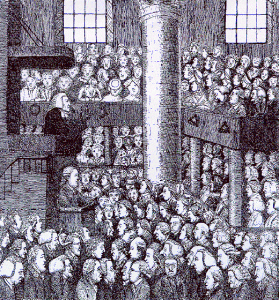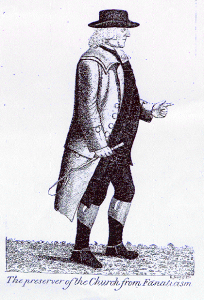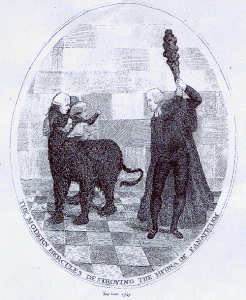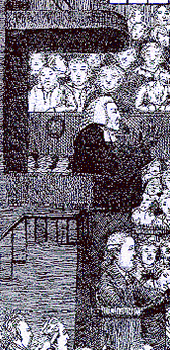Religion in Scotland
The Church of Scotland
The religious landscape of Scotland was singularly different from the situation that prevailed in England and in Wales.
In effect, after the ’Glorious Revolution’ of 1688 - 89, the established Church in Scotland was the Presbyterian Kirk (’Church of Scotland’). A debate evolved over the eighteenth century between ’evangelicals’ (sometimes satirised), who wanted to preserve a strict Calvinist orthodoxy, and the ’moderates’, influenced by the philosophy of Enlightenment. In 1788, the town of Edinburgh counted nine churches coming under the jurisdiction of the Kirk, of which certain were recent constructions.
The Church of England (’Episcopalians’), on the other hand, suspected of Jacobite tendencies and perceived as foreign, remained a minority for a long time. It is no doubt not fortuitous that the sole Anglican church in Edinburgh, built around 1771 - 4, on the model of St. Martin in the Field in London, was called the English Chapel.
It is in this singular context that Scottish Methodism developed, and had a chapel built in Edinburgh as early as 1765-6.
In the same way, there was scarcely any Baptist community in Edinburgh before 1765.
Associated for a long time with Jacobitism, Catholics represented an active minority, who were not able to construct a chapel before the end of the 1780s.
Smollett has one of his characters describe the religious situation of Scotland.
Religious architecture:
- St Mary’s Chapel
- Old Greyfriars’ Church
- St Andrew’s Church (Church of Scotland)
- Wesley’s Octagon chapel (Methodist)
Evangelicals
The Right Honourable Willielma, Viscountess Glenorchy, underwent an evangelical conversion that was, in many respects, comparable with the Methodist experience of regeneration, between her marriage and the death of her husband in 1786. Like Lady Huntingdon in Bath, she therefore spent a large fortune building a chapel in Edinburgh, “at the east end of the deep hollow which separated the Old Town from the New Town.” Before the opening of the new chapel on 8 May 1774, she had hired St Mary’s Chapel from 7 March 1770, in order to hear the gospel preached from an ecumenical, transdenominational viewpoint. Much as she would have liked her chapel to be an independent, self-governing institution, in communion with the Church of Scotland, but also open to Episcopalians and to “ministers of every denomination … who have a sincere love to the Lord Jesus Christ and the souls of men, and who preach the doctrine of justification by faith alone,” Methodists soon found that they were unwelcome there.
Lady Glenorchy’s chapel represents a few typical features of eighteenth-century religious life in Britain, such as the rise of evangelicalism, and the involvement of some aristocrats in the revival movements whose appeal was not necessarily confined to the lower classes.

- “A Sleepy Congregation”
- John Kay, “A Sleepy Congregation” (1785), A Series of Original Portraits and Caricature Etchings (Edinburgh: Hugh Paton, 1838), vol. I, p. 28.
[click on the picture to enlarge it]
The clergyman depicted here was Dr. Webster, the most evangelical in the city, who ministered for 47 years at the church known as “the Tolbooth church,” i.e; the South West portion of St Giles’s, whose ordinary congregation was noted for their ultra-Presbyterianism.
The pulpit has the usual double-decker structure.
An evangelical revival took place with Lady Glenorchy.
A comparison with Hogarth’s engraving of The Sleeping Congregation implies that the artist may have meant to caricature the lethargy of the evangelical party in the Church of Scotland.
The Moderates
The modern Hercules has borrowed the features of Dr. Carlyle, a representative of the moderate party within the Church of Scotland, fighting opposition from the popular party, represented by Professor Dalzel from the University of Edinburgh, Dr. John Erskine, minister at Old Greyfriars’ Church, the Rev. Dr. Andrew Hunter of the Tron-Kirk, and (with his hand up), the Hon. Henry Erskine, advocate.

- The Moderates
- John Kay, “The Modern Hercules Destroying the Hydra of Fanaticism” (1789), A Series of Original Portraits and Caricature Etchings (Edinburgh: Hugh Paton, 1838), vol. I, p. 66.
[click on the picture to enlarge it]

- The Moderates
- John Kay, “The Modern Hercules Destroying the Hydra of Fanaticism” (1789), A Series of Original Portraits and Caricature Etchings (Edinburgh: Hugh Paton, 1838), vol. I, p. 66.
[click on the picture to enlarge it]
The Baptists
The real beginning of the Scotch Baptist church dates back to 1765, when a small community separated from the established church and formed a Baptist meeting in Hammer’s Hall, Edinburgh. Not until 1811 did they erect a new chapel in Elder Street, which the city historian Hugo Arnot deemed to be “upon a very small scale” (1816).
The congregation reputedly included prosperous businessmen and artisans in the 1770s.


